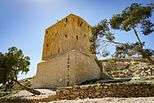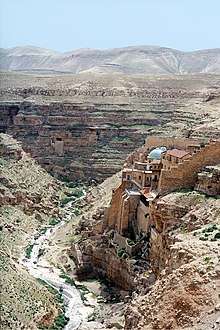Mar Saba
Coordinates: 31°42′18″N 35°19′52″E / 31.705°N 35.331°E

Part of a series on the |
|---|
| History of Palestine |
-Jerusalem-Temple_Mount-Dome_of_the_Rock_(SE_exposure).jpg) |
| Prehistory |
| Ancient history |
| Classical period |
| Islamic rule |
| Modern era |
|
|
The Holy Lavra of Saint Sabbas,[1] known in Syriac as Mar Saba (Syriac: ܕܝܪܐ ܕܡܪܝ ܣܒܐ, Arabic: دير مار سابا; Hebrew: מנזר מר סבא; Greek: Ἱερὰ Λαύρα τοῦ Ὁσίου Σάββα τοῦ Ἡγιασμένου; Romanian: Mânǎstirea Sfântul Sava), is an Eastern Orthodox Christian monastery overlooking the Kidron Valley at a point halfway between the Old City of Jerusalem and the Dead Sea,[2] within the Bethlehem Governorate of the West Bank.[3] The monks of Mar Saba and those of subsidiary houses are known as Sabaites. Mar Saba is occasionally referred to as the Convent or Monastery of Santa Sabba.[4]
The monastery was founded by Sabbas the Sanctified in the year 483.[5] Today, the complex houses around 20 monks. It is considered to be one of the oldest inhabited monasteries in the world, and still maintains many of its ancient traditions. One in particular is the restriction on women entering the main compound. The only building that women can enter is the Women's Tower, near the main entrance. The monastery is closed for visitors on Wednesdays and Fridays (the fasting days of the week).
The monastery holds the relics of Saint Sabbas. The relics were seized by Latin crusaders in the 12th century and remained in Italy until Pope Paul VI returned them to the monastery in 1965 as a gesture of repentance and good will towards Orthodox Christians.
Mar Saba was also the home of St. John of Damascus (676 - 749), a key religious figure in the Iconoclastic Controversy, who, around 726, wrote letters to the Byzantine emperor Leo III the Isaurian refuting his edicts prohibiting the veneration of icons (images of Christ or other Christian religious figures). John worked as a high financial officer to the Muslim Caliph Abd al-Malik; he eventually felt a higher calling and migrated to the Judaean desert, where he was tonsured a monk and was ordained a hieromonk (monastic priest) at the Monastery of Mar Saba. St. John's tomb lies in a cave under the monastery.
The monastery is important in the historical development of the liturgy of the Orthodox Church in that the monastic Typicon (manner of celebrating worship services) of Saint Sabbas became the standard throughout the Eastern Orthodox Church and those "Uniate" or Eastern Catholic Churches under the Roman pope which follow the Byzantine Rite. The Typicon took the standard form of services which were celebrated in the Patriarchate of Jerusalem and added some specifically monastic usages which were local traditions at Saint Sabbas. From there it spread to Constantinople, and thence throughout the Byzantine world. Although this Typicon has undergone further evolution, particularly at the Monastery of the Stoudion in Constantinople, it is still referred to as the Typicon of Saint Sabas. A tradition states that this monastery will host the last Divine Liturgy on earth before the parousia of Jesus Christ, therefore the last pillar of true Christianity.
Mar Saba is where Morton Smith purportedly found a copy of a letter ascribed to Clement of Alexandria containing excerpts of a so-called Secret Gospel of Mark,[6] and was for several centuries home to the Archimedes Palimpsest.[7]
.jpg) Mar Saba Monastery, 2011
Mar Saba Monastery, 2011 The Women's Tower at Mar Saba Monastery is the only building on the grounds that women are allowed to enter.
The Women's Tower at Mar Saba Monastery is the only building on the grounds that women are allowed to enter._Marsaba_Klosteret.jpg) Mar Saba seen from a distance.
Mar Saba seen from a distance. Mar Saba, in the Kidron Valley.
Mar Saba, in the Kidron Valley.
See also
References
- ↑ A lavra was historically a semi-eremitical monastic community, but most lavras today only have the name for historical reasons and follow a more centralized coenobitic regimen.
- ↑ "Mar Saba Monastery". Retrieved 24 July 2016.
- ↑ Melhem, Ahmad (9 May 2016). "Ancient Palestinian monastery under UNESCO consideration". Al Monitor. Retrieved 24 July 2016.
- ↑ John Lloyd Stephens (1837) Incidents of Travel in Egypt, Arabia Petraea, and the Holy Land
- ↑ Byzantine Monastic Foundation Documents Archived 2016-03-04 at the Wayback Machine.
- ↑ Morton Smith, Clement of Alexandria and a Secret Gospel of Mark (Harvard University Press) 1973
- ↑ The Archimedes Palimpsest Project. "The History of the Archimedes Manuscript".
External links
![]()
